This tactical analysis is in collaboration with Gavin Robertson’s opposition analysis for OL Reign on Washington Spirit. This first of two scout reports will highlight and detail Washington Spirit’s two most important players and detail their strengths, weaknesses, and how best to plan against them. The first scout report will be on Rose Lavelle. We will conduct an initial data analysis to identify her strongest and weakest statistics and if it can give us an indication of her potential strengths and weaknesses.
Lavelle is a 24-year-old central and attacking midfielder playing for Washington Spirit in the NWSL. Her role is that of a box-to-box midfielder making her skill set based on movement, positioning, and chance creation through dribbling and passing. This type of player would rely on intelligence in positioning to make smart off-the-ball movements to create space and get into positions to shoot or provide the final pass. While she has had an inconsistent few seasons in the NWSL, her success at last year’s FIFA Women’s World Cup was an example of the type of player she is and can aid us in this scout report.
Data Analysis
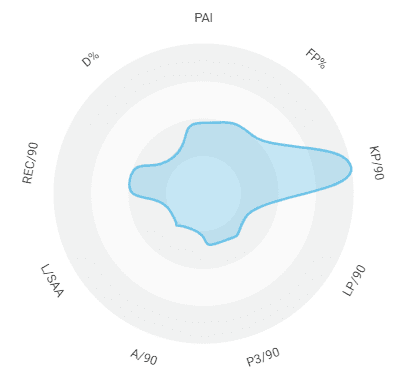
This data profile will provide us with an initial impression of the type of player Lavelle is and where she is likely to be strongest. Based on the graph above, we can immediately see how Lavelle is heavily reliant on playing key passes for Washington Spirit. Additionally, we can see some stretch towards long passes and passes into the final third. What this tells us is that Lavelle seems to be the team’s playmaker using her passing range to create opportunities for her team. However, her assists per 90 don’t seem to stack up, so there is some discrepancy when it comes to her conversation rate. Her recoveries per 90 seem to be a highlight here too, which could mean she is able to put herself about in midfield. This could also highlight her skill or role in a pressing system. Now we’ll look further into the data and rank Lavelle against other central midfielders in the NWSL against different metrics to find her strengths and weaknesses.
This data analysis comparing Lavelle against other central and attacking midfielders in the NWSL will tell us how she fares against them. We will look at three main categories for comparison including passing, ball progression, and defensive actions. The metrics involved will be Progressive runs vs Passes to penalty area per 90, Dribbles per 90 vs Touches in box, and Expected Goals (xG) vs Expected Assists (xA). These metrics will help us understand how well she places based on the profile we highlighted above and give us a better insight into her strengths and weaknesses. All the data used is derived from the 2019 season with players who have played 450 minutes or more.
Progressive runs vs Passes to penalty area per 90
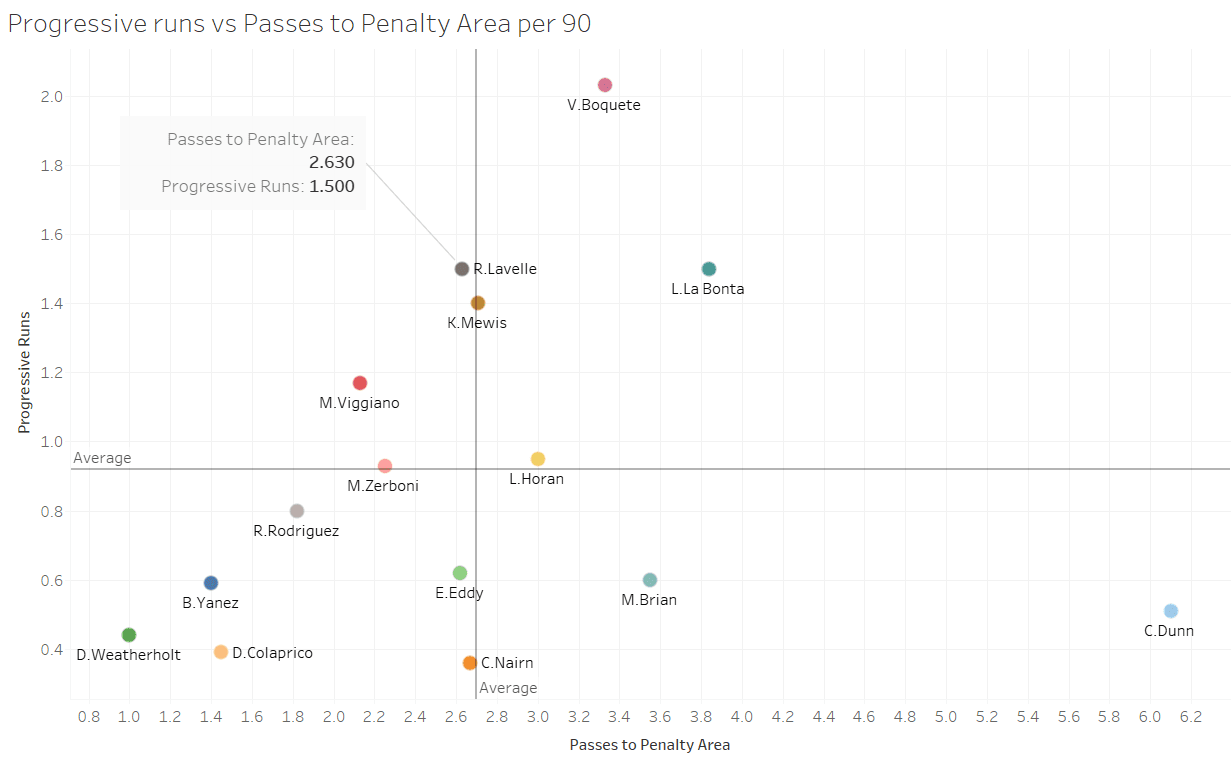
The first metric we’re going to look at is progressive runs vs passes to penalty area per 90. This will indicate ball progression and its effectiveness in getting it into the opposition’s 18-yard box. The initial results of this graph are telling in the spread of players across the four quadrants. The top right quadrant usually houses the top performers of any set of data comparisons. Here we see that Lavelle sits around the average mark for passes to penalty area with 2.63 and above average in progressive runs with 1.5.
This indicates that Lavelle is someone who is quite active in progressing play with her dribbling and is able to regularly penetrate through midfield and deliver passes to the penalty area. The highest performers are both from Utah Royals in Veronica Boquete and Lo’eau LaBonta. Boquete averages 3.3 passes to the penalty area and 2.03 progressive runs per 90 whilst LaBonta averages 3.84 passes to the penalty area and 1.5 progressive runs per 90.
Expected Goals vs Expected Assists
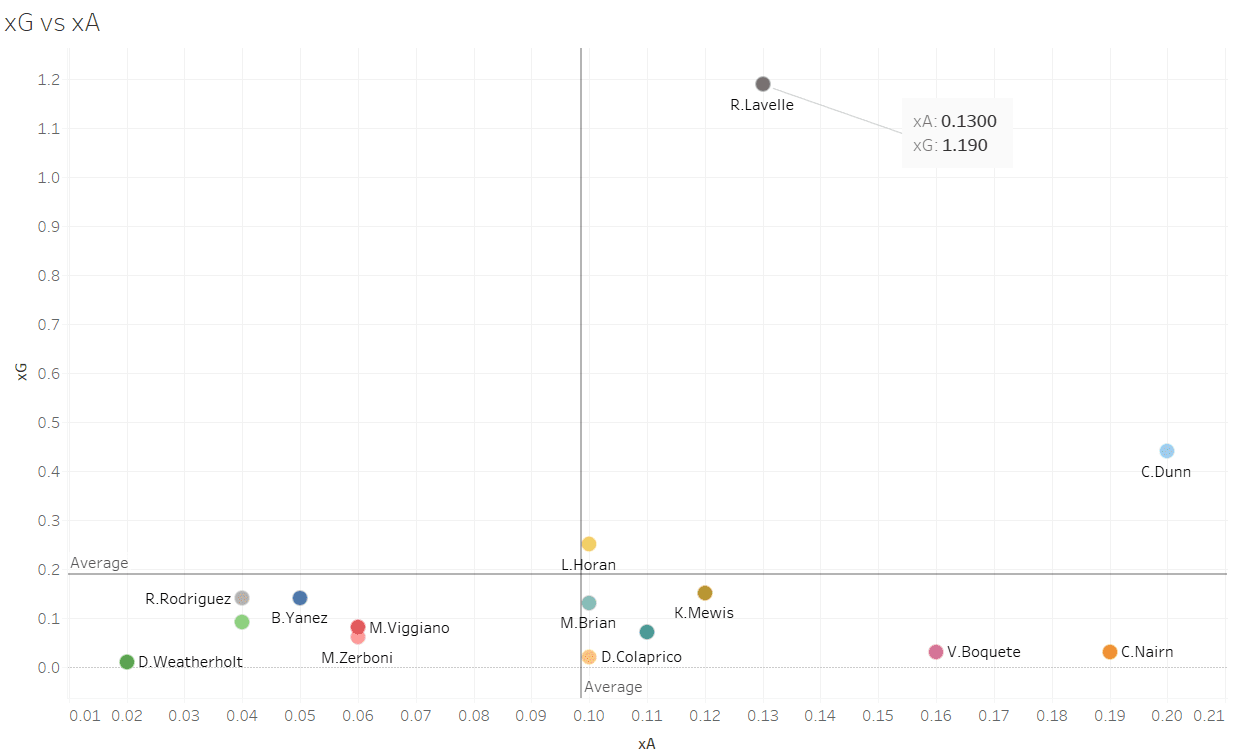
Next, we will observe and examine xG vs xA. This metric will decipher Lavelle’s all-round goal contribution to Washington Spirit. Lavelle’s average xG is quite high at 1.19 with an xA of 0.13. This signals that she seems to be much more of a goal threat than a playmaker. However, we need to take into account her 480 minutes of playtime against the rest of the league’s midfielders. Even if we take this into consideration, her numbers don’t stack up against her actual goals and assists figures of 1 and 0. She’s able to create chances to score and set up her teammates but she just isn’t clinical enough. Crystal Dunn and Lindsay Horan (formerly of Paris Saint-Germain) stand out amongst the rest of the trailing pack.
Dribbles per 90 vs Touches in box per 90,
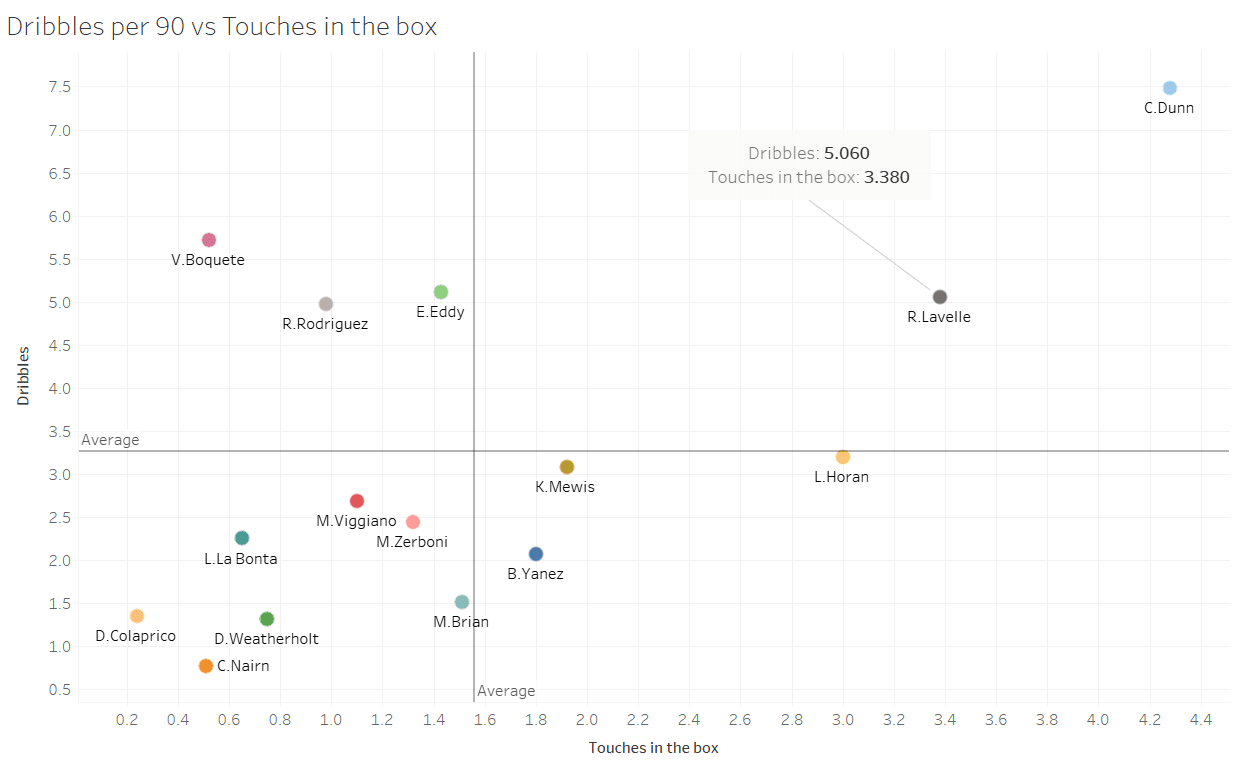
Lastly, we’ll explore dribbles per 90 vs number of touches in the box per 90. This will give us an indication of Lavelle’s ability to drive into the 18-yard box and ball carrying abilities. The results are good, with Lavelle amongst the top two performers in this regard. Lavelle averages 5.06 dribbles per 90 and 3.38 touches in the box. What this tells us is that Lavelle is a proficient and effective dribbler who is able to ghost past players and get into positions in the box. Dunn has the best figures with 7.4 dribbles per 90 and 4.28 touches in the box per 90.
After completing the data analysis portion of this scout report, we can derive a few conclusions from the initial data results. Lavelle is a competent attack-minded central midfielder who has exceptional dribbling abilities. Her influence and role in the middle third seem integral and crucial to how Washington Spirit play as they seem to be focused on progression through the central areas.
However, her output isn’t as high as someone of her talent and skillset should have and is an area that will be a highlight. Based on our initial assumptions, the next two sections will detail her strengths and weaknesses followed by how best to nullify her threat. We will focus on her movement patterns, ball progression, and decision-making as key areas of her play style.
Strengths
Before we dive into Lavelle’s strengths in her play, we need to understand the system she plays in to put these strengths into context. Washington Spirit have majorly relied on using the 4-3-1-2 formation, but have used the 4-3-3 as well. The Spirit look to progress play through the central areas and focus on getting their two forwards into play with the full-backs pushing up to give them width. Washington Spirit have an xG of 1.15 whilst their opponents register 1.41 against them. Being able to attack efficiently and effectively has been an issue. Lavelle typically plays as an advanced central midfielder whose role is to play from box-to-box, providing the team with an attacking drive through midfield and help in the build-up.
This suits Lavelle’s play style as it is predicated on vertical movement and positioning through dropping deep and being allowed to drive through midfield by linking play which can lead to two results. Making overlapping runs into the channels to either create a passing opportunity or play drive into the box herself to fashion a shooting chance.
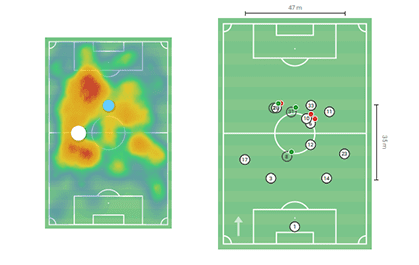
This heat map and average positions map shows us her usual area of play. We can see that her most active spots are just under the 18-yard box where she’s able to influence play with her ability to dribble and move with the ball under pressure. As we’ve mentioned earlier, she’s able to both dribble and play passing exchanges with her teammates to garner the most space to find passing or shooting opportunities.
This positions map dictates her average position in a game. Lavelle plays close to the strikers and has almost taken up a number 10-like position for herself for most of the game when attacking. There are times when she will drop deep and predicate herself in pushing the Spirit forward using her dribbling ability, evading pressing midfielders but for the most part will be an integral part of the attacking setup.
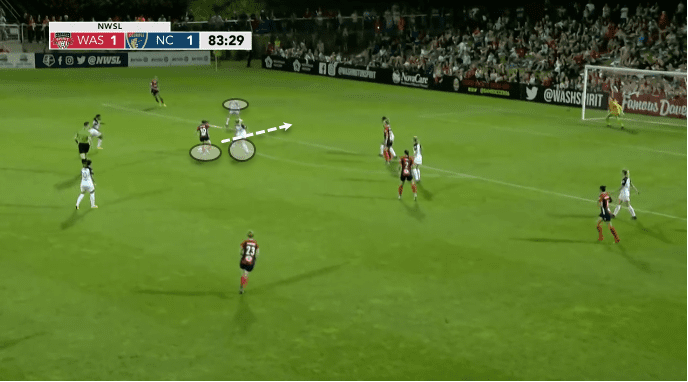
Lavelle has averaged 5.06 dribbles in her 480 minutes of play this season. While we need to take the number of minutes into account, it is still a high enough number to show her preference for wanting possession and driving through on her own. This example here shows us how effective she can be with the ball. Lavelle receives possession just outside the 18-yard box and is immediately surrounded by multiple NCC defenders. Lavelle takes them on and uses her quick feet to capitalise on the space available to get a shot away which results in a goal. Time and time again we saw this when playing for the United States Women’s National Team (USWNT) which is what made her so dangerous.
What we can also take away from this is her ability to move under pressure. This is possibly the most important factor of Lavelle’s game where she is able to thrive when faced with multiple players. Her 5.06 dribbles per 90 coincide with her 10.69 offensive duels. It can be classified as when the attacking player uses their ability and skill in an attempt to pass an opponent through a dribble. However, when the player in possession is required to protect the ball with their body, this is an offensive duel. While her success rate is at merely 35%, it is still quite a high number for an attacking player playing in a central position relative to her average number of offensive duels per 90. Only Boquete and Dunn, former Chelsea player in the FAWSL, both average 10 or more offensive duels per 90 with a 40%+ success rate.
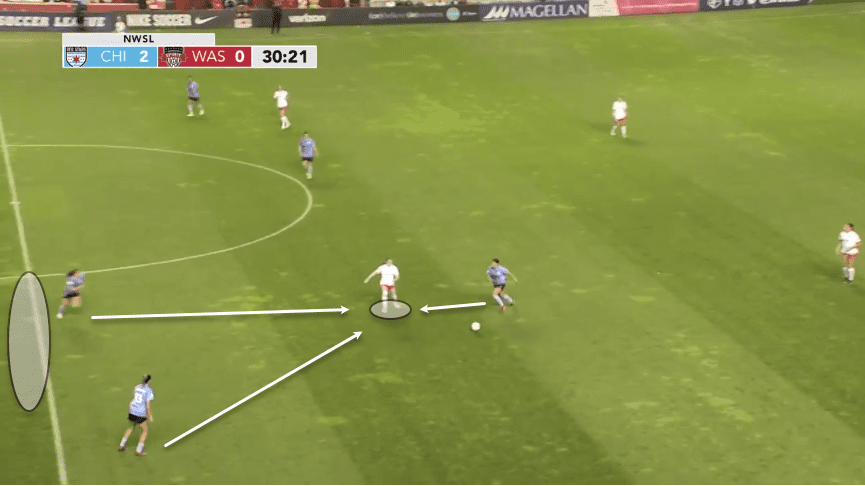
Being able to receive passes under pressure gives a team a lot of options to not only relieve pressure from other players but create space for teammates to run into. Playing a very central-focused tactic makes creating space very important. Teams that implement a high pressing strategy will look to put pressure on every part of the pitch and having someone of Lavelle’s quality gives Washington Spirit a good weapon.
The example here shows Lavelle asking for possession from her centre-back in a semi-dangerous position, not only because of the Chicago Red Stars players around, but because losing possession here would result in a potential counter-attack. When she receives the ball, it triggers Chicago Red Stars’ midfielders and strikers to converge on her to try and stop the next pass. Lavelle manages to get the pass away and in turn, manages to open up space in between Red Stars’ midfield and defensive line for Washington Spirit to attack.
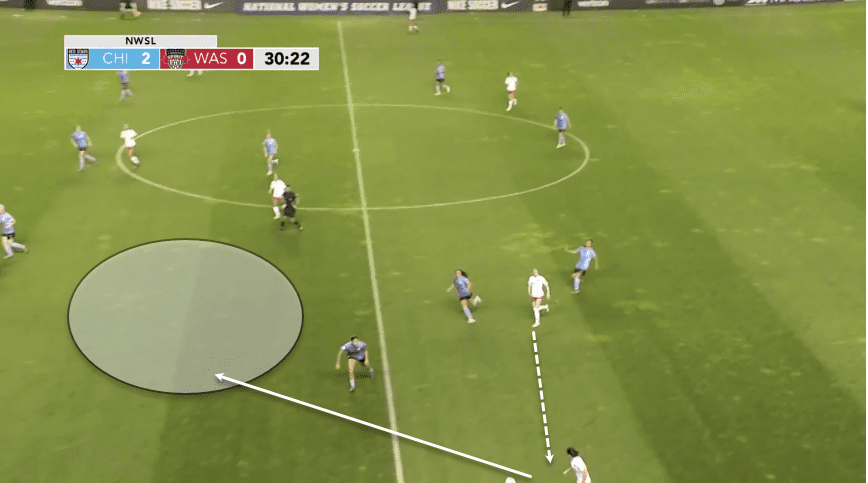
Weaknesses
Lavelle is an intelligent, explosive central midfielder but there are parts to her game that can be exploited to keep her from influencing proceedings. Based on the data and footage reviewed we found two main points that can be considered a weakness. One part of Lavelle’s game that she seemingly struggles with is her passing penetration.
In 480 minutes of play time, Lavelle has 0 assists with an xA of 0.13. With the positions she takes up and her frequent interchanges with the midfield, Lavelle should be much more effective with her passing range. Her passing numbers are frequent and have high success rates, but there is a lack of output when it comes to producing more assists. One of the reasons for this could be her lack of decision-making and her poor ability to time the right pass.
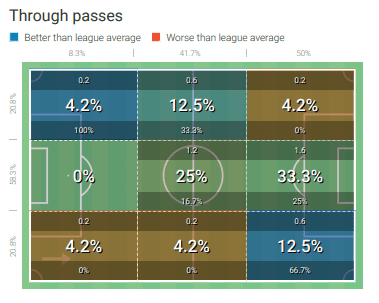
33.3% of Washington Spirit’s through balls come from zone 14 at an average of 1.6 per 90 and at a 25% success rate. Because Lavelle plays in these areas, you can expect her to be a central figure in providing these passes when she is on the field. Lavelle’s passes to the final third are 4.69 per 90 with an accuracy rate of 64%, however, her through passes per 90 sits at 0.56 with a success rate of 33.3%. What we can deduce from this data is that Lavelle is able to progress play through the thirds effectively, but when it comes to playing the final pass into the centre-forwards, the accuracy is lacking.
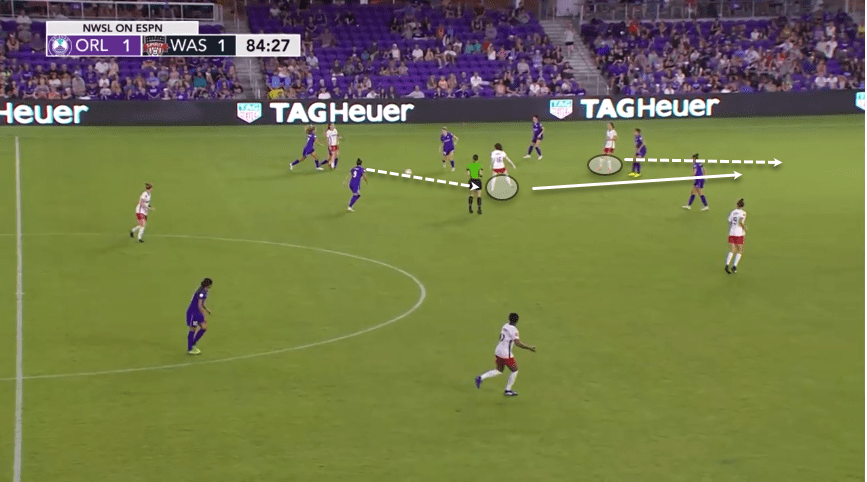
Lavelle has this ability to find space between the lines and uses it to create extra time in possession. In theory, this would allow Lavelle to make better decisions and choose the right option in terms of her passing options. Here against Orlando Pride, we can see how she’s able to move into space to receive the pass despite there being numerous players in the vicinity. Lavelle plays a first-time pass that is intercepted, however, she had enough time to take an extra touch and play the pass more accurately to allow the highlighted player a chance to penetrate in behind. Many of her through ball opportunities result in interceptions because of her poor accuracy.
How OL Reign can stop Rose Lavelle
Based on our analysis, we can conclude that Lavelle is an eccentric central midfielder through her dynamic movement and ability under pressure. With the success Reign have had against Washington Spirit in terms of Expected Goals numbers, it becomes even more imperative to stop Lavelle once she settles into a playing rhythm for the side. I believe there are methods in which to limit Lavelle’s attacking influence.
Firstly, we know Lavelle’s preference for vertical movement and interchanging play with her surrounding teammates. This coincides with Washington Spirit’s preference to play vertically too. Lavelle’s skillset is more suited towards making space and time to be able to get away passes and shots, however, as we’ve seen in the previous section, Lavelle’s quick thinking can let her down at times.
This can be broken into two phases – build-up and progression in the final third. If teams can stop Lavelle from having free movement in midfield, and force her into quicker passes, I believe there is a chance to limit how much she can do in the final third. Employing a man-marking system could be a solution by having a dedicated player from the double-pivot cover shadow her movements. However, this man-marking strategy doesn’t have to start high, and once Lavelle enters the double-pivot’s territory, the press can be engaged. The attacking midfielder in OL Reign’s 4-2-3-1 can start pressing high, as Lavelle won’t hurt teams deep in her defensive third – it’s only once she crosses into the final third. This way she is pressured from near her own defensive third into OL Reign’s defensive third.
We know that Reign’s double-pivot is critical to their system as they have the responsibility of keeping the side balanced. They look for opportunities to intercept misplaced passes, but they have to be careful not to overcommit and leave the defensive line without cover. As a result, having one defensive midfielder sit and track Lavelle’s runs is critical. OL Reign’s PPDA increased when they played against Washington Spirit from 8.81 overall to 7.6.
The increased pressing notion means that Reign look to apply more pressure on. Washington Spirit also have the highest number of passes per minute of possession in the NWSL with 13.2, which means they look to progress possession quickly and play at a higher tempo. However, the key to this working is Reign’s discipline in movement as a team and everyone understanding their roles. Any lapses in concentration, especially in the defensive third, will allow Lavelle to run at defenders and take shots which is her speciality. Covering spaces to plug in any gaps is critical.
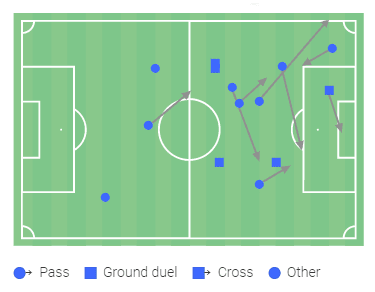
The above graphic illustrates Lavelle’s losses against Chicago Red Stars, where she was dispossessed 14 times. What we can derive from here is that Chicago Red Stars won possession off Lavelle outside of their 18-yard box with 7 of them by intercepting passes or crosses. Doing so will force Lavelle to adjust her style and while she is good under pressure, most of her losses have come slightly deeper on the left side of the pitch. Being constantly pressed will inevitably result in more possession turnovers but it will take a disciplined effort from OL Reign’s midfield.
Even if possession isn’t won back, OL Reign can force Lavelle to pass outward into the wide areas and force Washington Spirit to utilise their full-backs more. Washington Spirit ranks 9th in total and per 90 number of crosses in the 2019 season, so pushing them away from their favoured central area will be key.
Final Remarks
Lavelle is a dynamic, explosive central attacking midfielder whose game plan revolves around possession of the ball and driving her team forward. While she has only garnered 480 minutes for Washington Spirit, her influence to their side is immense. Once she settles into a rhythm, Lavelle will become a regular focal point for their side. Our initial data analysis uncovered some strengths and weaknesses and through the footage, we’ve been able to uncover where exactly they lie. I believe OL Reign have the setup and personnel to stop Lavelle but it will require discipline and defensive solidarity to maintain these tactics.






Comments